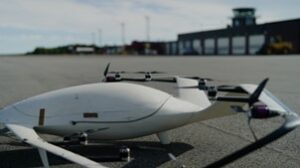
Skellefteå’s ELIS programme – an up-and-coming hub for the development and commercialisation of electric aviation – provides the space and competence needed to test, develop and certify vehicles, components and supporting infrastructure in real conditions.
During 20–22 September, a number of Beyond Visual Line of Sight flights were conducted between Skellefteå Airport and Northvolt’s gigafactory 13 kilometres away. The flights were done during ordinary scheduled and non-scheduled flights at the airport and in the airspace. The vehicle, a large wing drone from Swedish company Katla Aero, had a wing span of 2.5 metres.
Aviation test track
The flights are part of the project Test track for eVTOLs (electric vertical take-off and landing aircraft), co-funded by the Swedish Energy Agency. The project aims to not only pave the way for a test site for eVTOLs, but also investigate and learn more about the enabling factors that need to be in place to make commercial eVTOL operations a reality. The project consists of four work packages – ground infrastructure, business models, electromagnetic interference, and airspace and permissions. Among the partners are ACR, Luleå Technical University, Skellefteå Kraft, Northvolt, Skellefteå Science City and Skellefteå Airport.
‘By planning and conducting these flights, we gathered knowledge that would be hard to get otherwise. This once again shows the value of doing things for real and it’s a small but important step on the way to passenger flights with eVTOLs. There are definitely challenges ahead, some of them being highlighted by these test flights. One is the incorporation with other air traffic and permitting processes that need to be streamlined,’ says Robert Lindberg, CEO Skellefteå Airport.
To learn more and push the boundaries, different take-off and landing procedures were tested along with flights at different altitudes and speeds. The flights also simulated future passenger operations. On 22 September, a demonstration flight from Skellefteå Airport delivered aluminium cans for batteries to Northvolt in 7 minutes, compared to 30 minutes for ground deliveries. The top altitude was 120 metres, with a total energy consumption of 0.34 kWh.
-By demonstrating how fast, efficient and sustainable we can fly goods, and in the not so distant future even passengers, we hope that more stakeholders will see the opportunities here and develop potential business cases, says Sanna Bäckström, Communications Associate at Northvolt.
Outcomes
Key findings from the test flights include: establishing flight corridors, handling of eVTOL with scheduled passenger flights, optimal flight patterns, ground infrastructure needs, ways of communicating with air traffic control, and much more.
‘An entire ecosystem needs to work together to scale this up to commercial operations. The development of take-off and landing infrastructure, power and charging supply, airspace use, passenger processing, safety and security, maintenance and repair, educating pilots, integration with ground transportation, and much more. These test flights gave us even more input regarding all the stakeholders that need to be involved to make this work’, says Henrik Littorin, Programme Manager, ELIS.
Unique conditions
Skellefteå Airport, together with power company Skellefteå Kraft, has installed a 1MW power supply dedicated to electric aircraft and eVTOLs, and is developing a leading test bed for electric aviation. This is based on Skellefteå’s unique prerequisites regarding testing in cold, dark and windy conditions, with access to green and affordable electricity, a free airspace, and a broad competence within energy, electricity and battery development.
Contact information:
Robert Lindberg
CEO Skellefteå Airport
robert.lindberg@sft.se
+46 705517075
Henrik Littorin
Programme Manager, ELIS
henrik.littorin@sft.se
+46 734331998
Annelie Viksten
Project Manager, Skellefteå Science City
annelie@skellefteasciencecity.se
+46 738225826